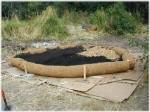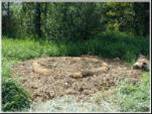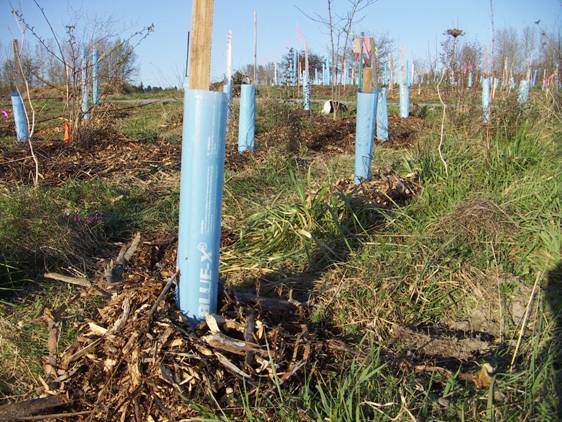

Construction and siting issues |
||
1. Hummock Islands Islands are large patches of soil and flora placed in the landscape in order to compete with existing vegetation. At the Hylebos Wetland in Federal Way, WA. The islands are used to out compete Reed Canary Grass, which has become a homogeneous community in the wetland. Installing trees within the islands has been successful so far in creating shade and possibly moving forward in the succession of the emergent wetland community to a forested wetland. The actual islands are built out of tough, biodegradable fibers such as quar and burlap base implanted with topsoil and a diverse, planned, plant palette. They can be very expensive up to $1000 each, but they are known to be very effective.
2. Mulching/sandwich mulching Organic mulch is a very important restoration planting technique that is used to retard the growth of invasive weed species such as pasture grasses. Mulch can be mounded around the base of newly planted trees and shrubs to provide moisture and give new plants an advantage over competitive grasses for sun and water. The application of mulch, then a layer of cardboard, and another layer of mulch is known as sandwich mulching and provides the most effective biodegradable weed barrier in its class. I have personally used this technique for over three years in my own garden, and it is used by Seattle P-Patch to keep weeds from growing over the pathways in the summer, and at the Union Bay Natural Area in their restoration efforts amoung pasture grasses, thistle and blackberry.
3. Stakes Stakes are an inexpensive, mostly effective way to reestablish shade in degraded environments. Stakes have been used in numerous projects locally. I have personally used them in restoration at the Union Bay Natural Area. Stakes can be successfully used to establish red osier dogwood, all sorts of willows, and red alder. Stakes can be cut from live tree branches and sprouts that are at least as big around as your small finger with at least 7 active leaf nodes. They should be placed into the ground so that only 2 or three nodes are left above ground. Stakes should be cut 2-3 feet long for greatest success. Success in staking the dogwood is the least successful and willow is the most successful.
4. Haying Haying is another inexpensive and effective way to grow vegetation. Haying is a way of seeding grasses, where the dry fertile hay is collected from a seed source and then laid within the area to be vegetated. The decomposing organic matter feeds the seeds, keeps down the weeds and the implanted seeds are given a chance to establish. This a very cheap way to get grasses in. A serious downfall of this method is the lack of control on what kind of seeds get in. It is hard to guarantee that no invasive seeds are carried in in the process.
5. Large Woody Debris LWD LWD is the term used to describe large pieces of fallen wood, cut logs, and such that are manipulated into habitat creation and food sources in the landscape. The logs and branches can be buried into the ground, stacked upon one another or tied together are common applications of the material. Birds often use the pieces of wood as perches, plants use logs as nutrient source (nurse logs) small mammals as shelter, insects as food (snags) and humans as seating. LWD can also be used for flood control and drainage management. One way of “planting” LWD is to dig it under at an angle and bury half of it. This helps it retain moisture, rot, and stabilized it. Another way to plant it is within stream beds. Many are anchored in, but this is not recommended because of the litter that remains when the wood rots away. If there are a biodegradable anchoring option that would be preferred. Otherwise, we suggest burying the logs into the side of the stream bed to prevent them from coming loose and damming, causing floods. LWD is used to retain moisture locally. Plants planted on the north side of LWD are offered shade and added moisture as well.
6. Native Plant Salvage Plants can be salvaged prior to construction and reused in planting after construction is complete. They can be grown and/or nurtured in a nursery on or off site, and returned for planting at the appropriate time, preferably within a year. Salvage can be arranged through the county administration in King and Snohomish Counties, and through the WSU Master Gardener Program in Lewis, Pacific, Mason, Grays Harbor and Thurston Counties for governmentally sponsored projects.
9. Exclosures Exclosure made from fencing materials can be effective at deterring herbivory by geese and deer. This practice has been used for quite some time by gardeners around the world. Locally it has been used to ward off grazing geese along the Duwamish River restoration sites with some suceess. The trick is to keep the diameter of enclosures smaller than 2 times the wing span of a goose. (3-4’). They do require some monitoring and maintenance but are effective when they are maintained properly. 10. Mowing and Dicing Mowing can be a great way to manage large areas of invasives such as blackberry and thistle. It prevents seed creation and dispersal. Mowing around young trees can allow for more water uptake. It is cheap and relatively less intense than pulling up the plants by hand, though not as effective in ridding the area entirely of the plant.
11. Clearing Invasives Invasives including Himilayan Blackberry, Ivy, Thistle, and Scotch Broom must be removed by hand or with the help of equipment to ensure it does not return oe returns with less vigor. Consult the Noxious Weed Control Board for recommendations related to species specific details and instructions.
12. Tree Shelters Tree shelters are tall cylindrical vertical tubes used to retain moisture and heat for newly planted young species. They perform much like green houses. Blue-X are a popular brand and has been used at the Union Bay Natural Area. Tree shelters also can help protect against herbivory. They are considered to be essential in many restoration projects on degraded soils.
13. In-Planting Plants can also be established new on the site. Some plants are easier to establish in certain ecosystem types, and are a preferred 1 st step in planting for re-vegetation regimes. For a list of these hardy plants per eco-system, please consult the appendix |
||
|
||



